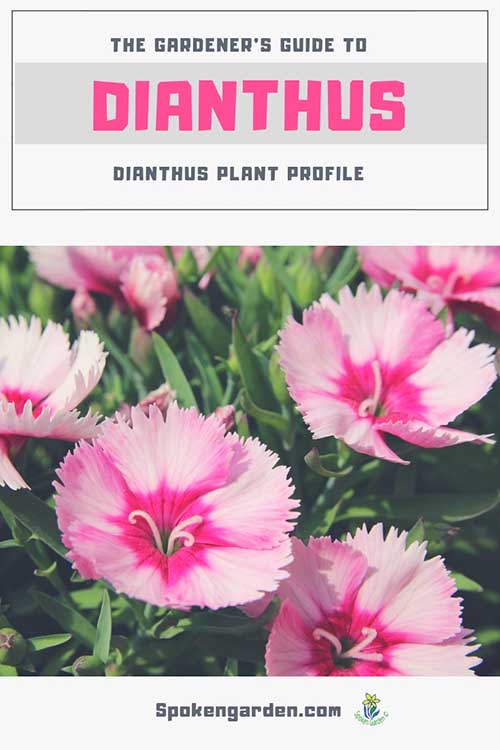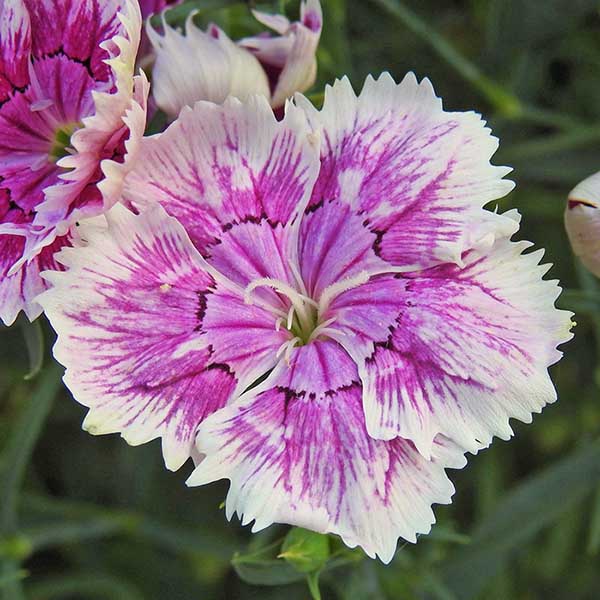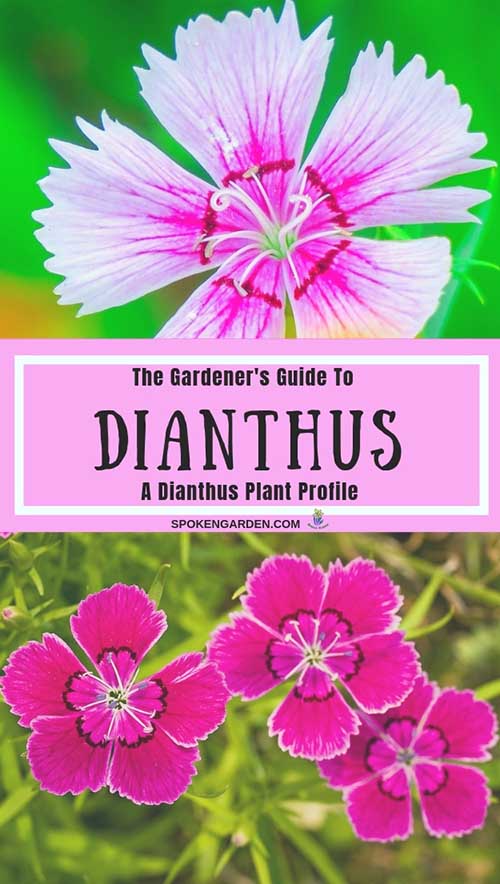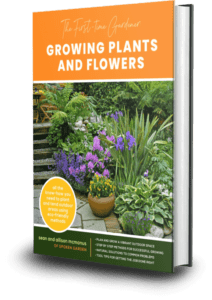Perfect for containers, borders, and baskets, Dianthus will add pops of color to any garden. Learn about these beautiful, easy-to-grow plants in this gardener’s guide.
Dianthus plants have graced gardens around the world for centuries.
If you were to travel back in time to Ancient Greece, you would observe these small, colorful flowers all over as they were revered for their heavenly appearance and aroma.
Over time, these “divine” flowers have spread and became a staple in cottage gardens around the world.
Quick Plant Care Facts
| Sun Exposure | Full sun, in most climates, to light shade in hottest climates. |
| Water Needs | Regular water. Don't over-water plants. |
| Soil Needs | Most Dianthus thrive in light, fast-draining soil. Some need more of a rocky type of soil while other need more of a fairly rich soil. Plants do prefer a more alkaline soil than acidic (neutral to higher pH). |
| Cold-Hardiness Zones | USDA hardiness zones 3 to 9. |
| Bloom Time | Mainly from spring to early summer. Some will re-bloom later in season or keep blooming into the fall, if dead-headed. |
| Flower Colors | White, shades of Pink, Rose, Red, Yellow, White, and Orange. |
| Mature Height/Width | Can vary, from low growing mats or grass-like tufts to small shrubs ranging from 12 to 20 inches tall and wide. |
| Plant Spacing | Can vary by species and growth habit. Mat or grass-like tufts need a minimum of 6-10 inches or more spacing. For cut-flowers, like Carnation species, space plants close together for taller flower stems, in general. Closer planting is common for cut-flower species and harvesting longer flower stems. |
If you are looking for Summer Flowering Bulbs to add to your garden, look no further than our ebook
21 Spring-Planted Bulbs For Fantastic Summer Color!
It’s has 60+ pages of summer flowering bulb inspiration and you can get to know the different plant care needs of these 21 gorgeous spring-
planted, summer-flowering bulbs.
Whether you are already familiar with bulbs or are just learning about them, this guide explains what bulbs are, defines the 5 different types of bulbs, the correct planting orientation for each of the 5, and much more.
You also get to know each of these 21 spring-planted, summer-flowering bulbs intimately for their care needs like where they will grow, when they flower, different flower colors they are available in, and which online-retailers you can buy your very own to then add to your garden.
Grab your copy now and start planning your spring and summer flower garden TODAY!
In our Dianthus plant profile below, you’ll learn why everyone loves these beautiful plants and why they’re considered so useful. By the way, our dianthus plant guide below is meant for beginner gardeners but can be used by anyone who wants to learn more about this plant. We hope you enjoy it!
If you aren’t sure where to start learning about gardening, go to our Start Here page where you can get find beginning gardener topics by listening, watching, and reading.
By the way, if you’re wanting to add more classic Dianthus flowers to your garden, Sweet Williams are a perfect choice! These specific Sweet Williams are favorites of ours and would be perfect for you!
In a hurry? Pin it for later!!
Watch Us on YouTube
Dianthus: Why We’re Featuring This Plant
First, Dianthus flowers are beautiful and come in a variety of colors and shapes. Whether pink, purple, white, yellow, or red, the small, vibrant blooms add beautiful pops of color to your garden.
Dianthus is suitable for borders, rock gardens, container baskets, potted displays, and ground covers.
In addition to their beauty, these versatile plants are really easy to maintain. With just a bit of deadheading for spent flowers, dianthus can re-bloom and be enjoyed throughout many seasons as long as they have proper care.
Some are even fragrant. Their low maintenance needs are perfectly suited for both beginning and weathered gardeners.
Finally, we’re featuring dianthus because of their frost tolerance. Even though they are usually considered a spring and summer bloomer, the flowers bloom all different times of the year depending on your zone.
Dianthus is a cool-season flower (in many zones) which makes them perfect for a fall garden. Plus, if you want to plant dianthus mounds in your garden, the fall season is the perfect time due to the cooler temperatures.
Is Dianthus an Annual or Perennial?
The answer is “it depends”.
It depends on a couple of things. First, if your particular Dianthus species germinates from seed, grows, flowers, and then dies all in the same calendar year or if it continues to grow year after year in your garden. Also along with how long it lives, where your garden is located and if any specific Dianthus plant is hardy and tolerant enough to survive and overwinter, with other needs, at that location.
If hardy enough to be a perennial in your garden’s location, then you can expect it to keep coming back year after year. If not hardy enough and can only survive part of the spring through to mid fall, then you can consider it an annual in your area.
If you have the right growing environment or can help protect Dianthus plants during extreme weather conditions, then you can most likely add it to your garden.
Make sure to read the plant profile table above to find out if Dianthus is right for your garden.
If you aren’t sure where to start learning about gardening, go to our Start Here page where you can get find beginning gardener topics by listening, watching, and reading.
Dianthus Flowers: History and Uses

Our Dianthus Plant Profile highlights how you can care for Dianthus in your garden (click on the graphic above to save this for later).
Dianthus Family
Dianthus is in the plant family Caryophyllaceae which includes the Carnation, a popular species of the Dianthus genus.
This family group includes over 300 species of flowering plants including annuals, perennials, and biennials.
Other members of the Caryophyllaceae family include carnations, baby’s breath, chickweed, and more.
Dianthus History
Dianthus has a long, complex history going back to Ancient Greece. The name Dianthus originates from the Greek words dios which means ‘divine’ and anthous which means ‘flower’ so named by the Greek botanist, Theophrastus, who some consider the father of botany.
Dianthus originated in Eurasia and were first revered in Ancient Greek culture. The flower has also been referenced in Roman culture and history.
Eventually, Dianthus found their way to England by the late 1500s, most likely by the Romans, and were used as a popular flowering plant for gardens. They were also grown for their edible nature. Some stories claim that some people may have paid their rent with Dianthus and they were so beloved that royalty had their portraits painted with them.
The flower endured several name changes over the centuries depending on its location and use throughout history. For example, the names “Sweet William,” “gillyflower,” “Pinks,” and “Carnation,” have all referred to Dianthus at some point.
In Ancient Greece, Dianthus was considered a divine plant due to its beautiful appearance and the wonderful scent of a spicy, clove-like aroma. Research suggests that Dianthus was one of the flowers used in ancient Greek ceremonial crowns.
By the 17th Century, people began deliberately breeding Dianthus in England. Over the course of the next two centuries, hundreds of cultivars became commercially available. The flower’s popularity spread to America as well during this time.
Eventually, Dianthus species became an integral part of gardens due to their charming forms, colors and often wonderful fragrances, depending on the variety. People also used the flowers for flavorings in wine, soups, sauces, and jams throughout the years.
Today, Dianthus remains one of the most popular flowering plants in gardens around the world. In both Britain and the U.S., interest in old cottage garden plants, like Dianthus, continues to thrive.
Currently, Dianthus is one of the most popular flowers found in cottage gardens throughout the world due to its versatility and attractiveness to pollinators. Its also popularly used as a cutting flower because it can last for multiple weeks once cut.
Dianthus Plants For Sale
Want to buy your own dianthus plants for your garden?
This assortment of seeds below from Eden Brothers would be perfect for your garden! We love Eden Brothers because their seeds germinate so fast and have high viability (and they have fast shipping if you want your order quickly). Check out this selection below.
By the way, as affiliates, we have a coupon for you for 15% off your order. At checkout, type “SPOKEN” into the coupon code box. You will know you got the coupon when it says, “Coupon applied: 15% off- Spoken Garden Listeners.”
Have fun shopping below!
P.S. We have another gift for you since you love learning about plants. Have you ever considered listening to an audiobook while you work in the garden? If you sign up for a free trial of Amazon Audible, you can get 2 free audiobooks upon signup! We listen to our favorite books all the time while we’re on the go. Find out more here!
Dianthus Care Videos
Dianthus Plant Conclusion
In addition, Dianthus requires very little maintenance. They are perfect for containers, borders, and rock gardens because they add color, texture, and interest to your garden while requiring little water, fertilizer, or general care. Plus, they can endure cooler temperatures.
Dianthus are perfect for beginning gardeners to more experienced gardeners due to their qualities and versatility in different types of landscape settings. It’s no wonder they have remained a favorite in gardens the world over.
If you aren’t sure where to start learning about gardening, go to our Start Here page where you can get find beginning gardener topics by listening, watching, and reading.
Want to learn about other plants in your garden? Check out some of our previous plant profiles:
- Chrysanthemums: A Gardener’s Guide and Plant Profile
- Sunflowers: A Gardener’s Guide and Plant Profile
- Shasta Daisy: A Gardener’s Guide and Plant Profile
- Hellebore Gardener’s Guide and Plant Profile
- Roses: A Gardener’s Guide and Plant Profile
- Daffodils: A Gardener’s Guide and Plant Profile
See you in the garden!
~ Sean and Allison
P.S. Find us on Pinterest, Twitter, Facebook, and Instagram so you don’t miss a thing!
Dianthus References Used:
Perfect for containers, borders, and baskets, learn all about the beautiful, easy-to-grow Dianthus plant in this gardener’s guide.




